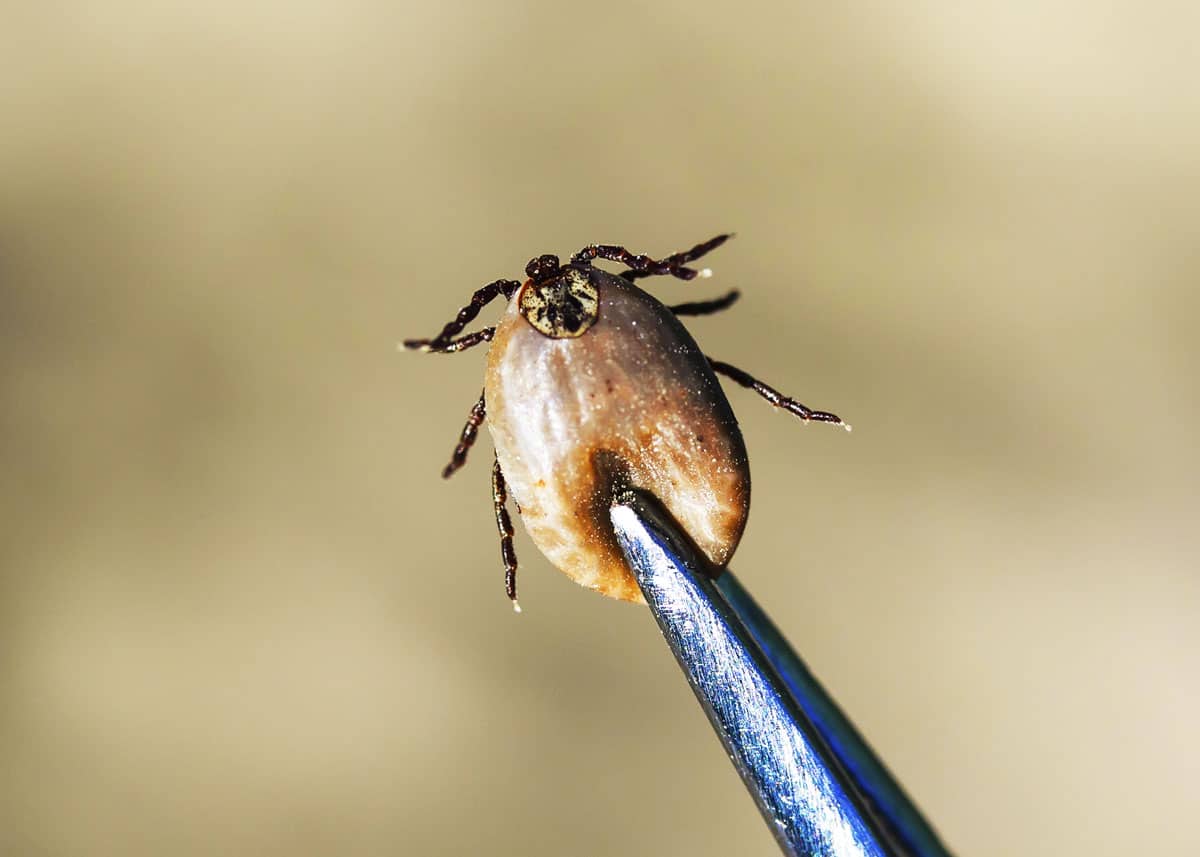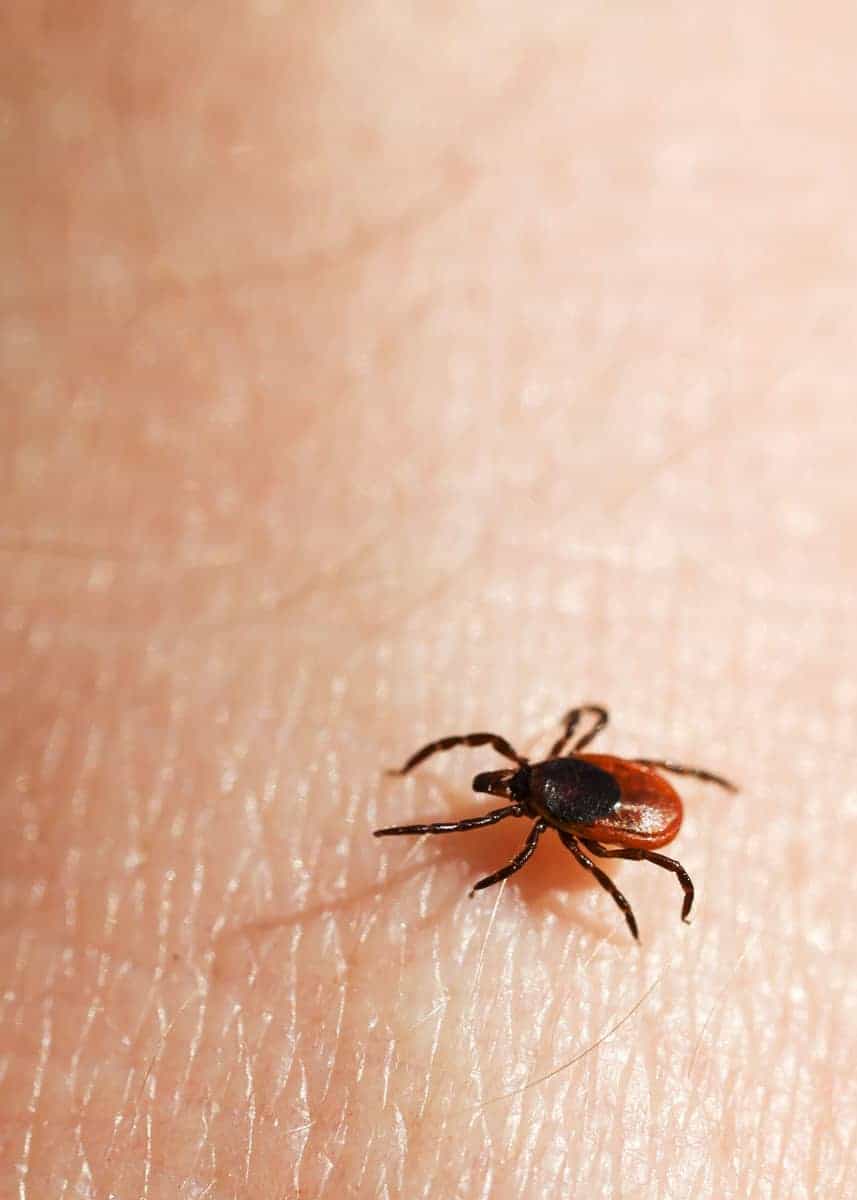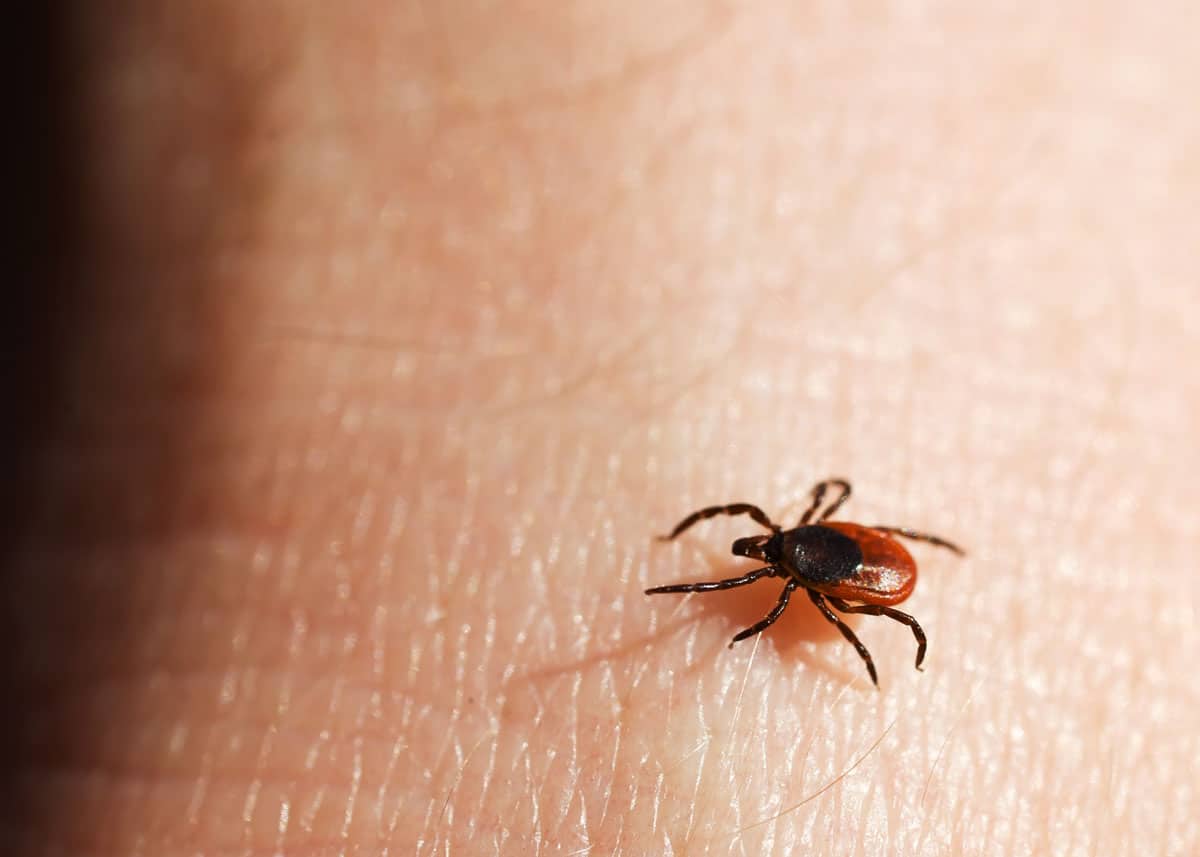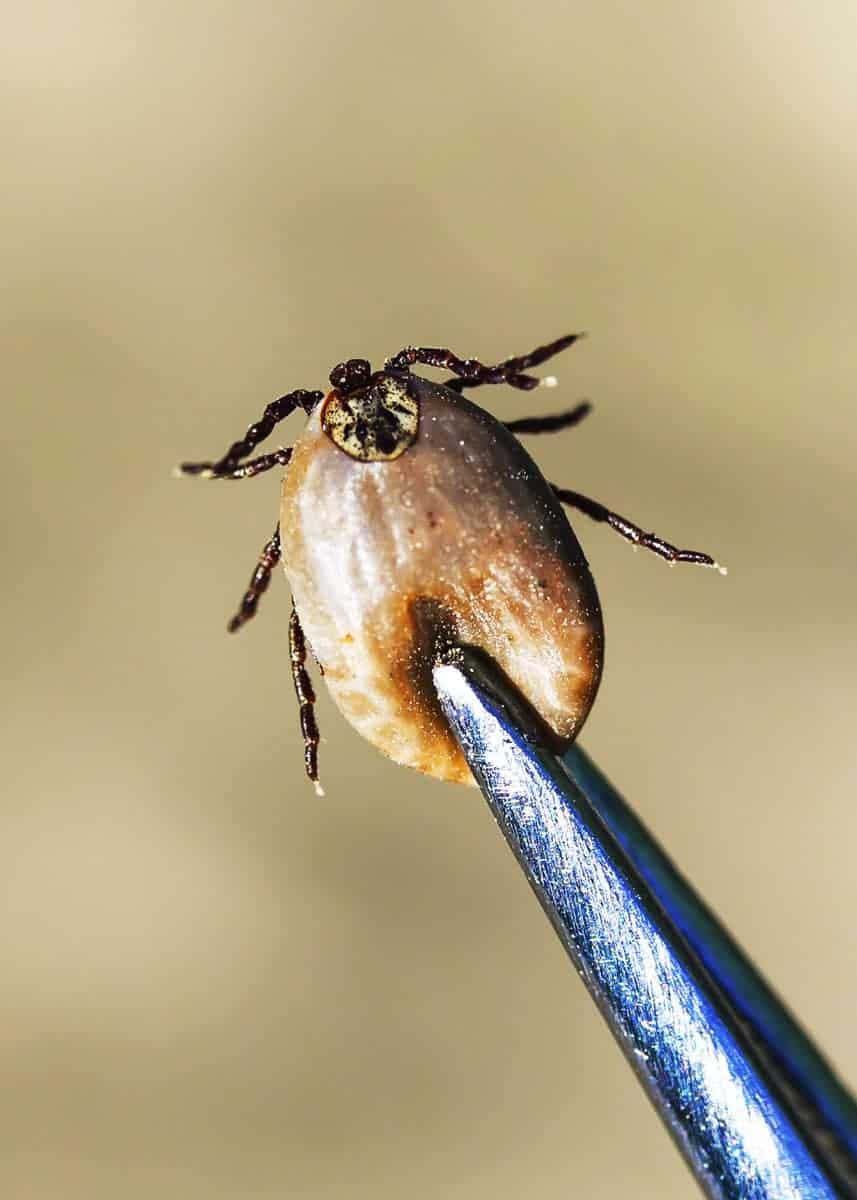How to Kill a Tick in 13 Ways (and 18 Other Gross Facts)
You hate ticks. I get it. Here are 13 ways to kill a tick (including squish, crush, burn, drown, and suffocating). Plus 18 answers to common questions about these infectious blood-suckers. You’ll also learn why squishing a tick is the worst idea – it is a health risk for you and your family.
How to Kill a Tick (Squish, Crush, Drown, Burn…)
Yuck! There’s a tick on your arm! What are your options for quickly and safely removing it? What do you need to know about potential disease transmission? What do you do with your clothing afterwards?
If you’re having a tick problem, the first step is not to panic. There are many ways to kill these greedy little bloodsuckers, and you can greatly reduce the risk of illness and infection when you dispose of them correctly.
Here are just a few tips and tricks if you’re wondering how to kill a tick.
13 Ways to Kill a Tick
1. Squishing
You’ve probably heard that squishing a tick is dangerous. You’re right!
If you squish or squeeze a tick that’s actively feeding on you, the pressure can cause them to regurgitate their stomach contents into your open wound.
Not only is this a gross thing to think about, but it will also increase your risk of blood-borne illnesses.
Once the tick has been removed from your body, however, there’s nothing wrong with squashing it. It will kill it – effective and primitive.
There are just two things to keep in mind:
- Don’t get their insides on you. An engorged tick is full of blood and other tick juices. If you are too zealous in squishing it, you’re liable to get some on you or your kids.
- Just make sure that you do it with a rock or boot instead of directly pinching it between your fingers. You should never handle a tick with bare hands. Their bodies are crawling with bacteria, so even if they’re completely intact and not in any danger of regurgitating, they still aren’t safe to handle.
Something to note is that there are both “soft” and “hard” tick breeds, and it might be more difficult to squish a hard one. It might have a tough shell that requires more pressure to break. This is completely normal, so don’t worry if you stumble across a terminator tick.
2. Pesticides
There are several pesticides that can be used to kill ticks:
Permethrin is a compound that attacks the nervous system of insects. It’s available in sprays, powders, aerosols and liquids, so you’ll have plenty of options as an exterminator. Sprinkle it around your garden; put it in an automated misting system in your backyard. You can even soak cotton balls in a permethrin solution so that mice and birds will use them for their nests and kill ticks seeking a new host. See size and current price on Amazon.
- Fipronil is a common ingredient in bug sprays. It attaches to their nerve endings and causes death within seconds. Depending on the type of insect that it’s being used to repel, fipronil is available in everything from gel baits to liquid treatments for wood products, so you’ll need to do your research to find a product that works on ticks.
- Bifenthrin is another commonly-used pesticide for ticks. Like permethrin, it attacks the nervous system, so it can kill on contact or over a period of time. It also binds well to soil, so it’s ideal for outdoor use. If you’re trying to keep ticks out of the tall grass in your backyard, consider a bifenthrin spray.
All of these pesticides are considered harmless to humans, so they’re safe to use in homes and gardens.
Just be careful if you have pets or other animals on the property. Cats are sensitive to permethrin; bifenthrin will kill fish; fipronil is highly toxic to honeybees.
You’ll need to be careful when trying to balance the needs of your ecosystem.
3. Chemically-Treated Water
It’s hard to drown a tick. They can survive complete submersion in water, so you won’t see any results by trapping them in a water-filled container.
The same thing goes for toilets. When you flush a tick down the commode, you aren’t actually killing it! You’re just sending it on a high-speed water slide to another location.
If you want to drown a tick, you’ll need to add some chemicals to your water. Rubbing alcohol is one possibility. So is mouthwash that contains alcohol. Despite the fact that they’re liquids, their chemical compounds will dry out the ticks from the inside, and the desiccation will cause death anywhere from a few minutes to a few hours later.
Never apply rubbing alcohol to a tick that’s still attached to your body. This method is only meant for captured or live ticks that you’ve already removed from the skin. If you douse a feeding tick with alcohol, it might get agitated and release more toxic saliva into the bite wound.
4. Natural Methods
The web is full of home remedies for tick removal, but which ones are truly effective, and which ones are just old wives’ tales?
Essential oils are a keeper. Several plant-based oils have been vetted by the CDC as tick repellents, so even if the organization can’t vouch for their effectiveness, they’ve been cleared as safe to use around humans.
Here are a few compounds that have gotten CDC approval:
- Rosemary
- Lemongrass
- Garlic
- Cedar
- Thyme
- Peppermint
There have also been individual studies on essential oils for tick removal. For example, the Maine Medical Center Research Institute discovered that rosemary oil is “almost as effective as bifenthrin” when administered to a home or garden with a high-pressure hose.
Check out this camper’s guide to essential oil bug repellent.
What about tick removal methods that don’t work? Some home remedies are pure nonsense – especially when used to remove a tick:
- Petroleum jelly
- Nail polish
- Dish soap
- Kerosene
- Glue
So while these items can kill a tick – they are very dangerous to use when removing an attached tick. To make matters worse, they can aggravate live ticks that are still attached to the skin. If you want a genuine home remedy for ticks, stick with essential oils and not beauty or bathroom products.
5. Hot Water
You can use your washing machine to get rid of ticks. Hot water is an effective way to kill them without having to squish, squeeze or scrape their bodies off your clothing. Before you toss anything into your Whirlpool, however, you might need to adjust the temperature settings of your rinse cycle.
You see, ticks can’t be drowned. It isn’t the water in the washing machine that kills them. It’s the heat.
In a study on black-legged ticks put through residential washers and dryers, the temperature needed to be above 130°F (54°C) for every single tick to die.
When the temperatures were lowered to 80°F – 115°F (27°C – 46°C), most of the ticks survived the wash.
And when put through a cold cycle, all of the ticks survived.
The results are clear: Your washing machine needs to be on a high heat setting if you want to use it as a tick-killing tool. If you go easy on the bugs, they’ll continue to thrive.
6. Suffocation
This method won’t give you the satisfaction of stomping on a pesky bug, but it’s one of the safest and most responsible ways to kill a tick. Not only will it keep your hands clean, but it will also save the tick for further testing just in case your child or pet starts to show symptoms of Lyme disease.
Suffocating a tick is simple. Just drop it into an airtight jar or sandwich bag and wait a few days. The tick will die from a lack of oxygen, and its body will be perfectly preserved if you ever need to send it off to a lab.
Do you remember those home remedies that we talked about? Some of them claim that you can “smother” a tick in nail polish or petroleum jelly, but this is a myth. If you want to suffocate a tick, you’ll need to completely cut off its oxygen by encasing it in a sealed container. Applying a coat of nail polish to its back might just make it pretty as it feeds on you.
7. Heat
Heat can be used to kill ticks, but as we’ve already discussed, it needs to have a high temperature. It also needs to be the right kind of heat.
For example, if you’ve already plucked a tick off your leg, there’s no harm in tossing it into the campfire or setting it ablaze with a lighter. A direct application of heat will kill it right away.
You don’t want to burn a tick that’s embedded in your skin, however. Not only will you risk burning your own body, but you’ll also cause the tick to secrete more saliva. The saliva of a tick is filled with toxins, so trying to “burn off” an embedded tick is just as dangerous as squishing it.
If you’re using a dryer, it takes around six minutes on a high heat setting to kill all of the ticks on towels and clothes. This was proven in the washer and dryer study. If you want to get the ticks off your favorite hunting jacket, toss it into a dryer with a temperature setting of 129°F – 185°F (54°C – 85°C) or more.
Long story short, heat is an effective way to kill ticks. Just be careful with the “when” and “where” of using it, and make sure that your dryer is hot enough!
8. Tick Removal Tools
Tick removal tools are special gadgets that you can find in retail and hardware stores. They come in several varieties:
Tweezers: Specialty tweezers for tick removal are the best tool for the job. They have fine-tips allowing you to grip the head and not squeeze the body. Here’s a good option with two types of tweezers in one.
- Pliers: Some tick pliers have a built-in magnifier for identifying the tick and to inspect the bite sight. Here’s one good option.
The simplest tools are plastic tweezers that you can use to grab a tick and pull it off. The fancier tools might have everything from magnification lenses to slide chambers that will hold live ticks for further testing.
You should know that tick removal tools don’t actually kill ticks. Some of them are only meant for removal, capture or identification. If being able to kill a tick on sight is important to you, make sure to buy the right tool for the job.
9. Thread or Dental Floss
If you’re hiking or camping in the middle of nowhere, you might not have access to things like specialized tick removal pliers. But you aren’t out of luck. You can kill ticks with the sewing kit that you have tucked into your backpack!
Start by cutting a piece of long, thin thread. Loop it around the tick’s mouth parts. Get it as close to your skin as possible.
Once you’ve lassoed the tick, tug it upwards with a slow, steady pressure. Treat this removal process just like using a pair of tweezers.
Once the tick is removed from your skin, decapitate it by tightening your grip on either end of the thread. This is especially easy if it’s a large, fat tick that has a bloated body from feeding; if it’s a smaller or more recent tick, it might not be big enough to be visibly beheaded.
Note that you don’t have to use sewing thread for this tick removal method. You can also use dental floss or anything else that’s long, thin, reedy and strong.
10. Diatomaceous Earth
Diatomaceous earth (DE) is one of the best bug killers out there, and it can help with your tick problem, too.
Diatomaceous earth is made from the remains of tiny aquatic organisms like phytoplankton. It comes in powder form and can be sprinkled over just about everything in your home and yard, including carpets, counters, gardens, windowsills and driveways.
It works in several ways. On bugs with hard exoskeletons, it can creep under their armor and tear them up with minuscule, sharp-edged granules. On bugs that need moisture to survive, it can dry them out until they’re dead.
Ticks are vulnerable to both of these things, so diatomaceous earth is a one-two punch in terms of efficacy. Hard ticks will die when it gets under their “plates.” Soft ticks will die when it desiccates them.
Consider diatomaceous earth if you want to kill ticks on a systematic level. If you’re suffering from more than just the occasional tick picked up by your pet rabbit, DE can be just what you need to stop an infestation.
11. Tape
Tape is another one of those quick-and-dirty methods that can work on ticks if you don’t have access to more sophisticated tools. You can use it in several ways:
- If the tick is hanging on your hair or clothes but hasn’t started to feed yet, you can use the tape to remove it without touching it. Think of it like using a sticky fly trap or a lint roller.
- If you need a safe way to kill a tick after plucking it from your body, you can press it into a piece of tape and let it dry out over several days.
- You can also tape it to an index card after writing down the day and time of your bite. You might need this information later for identification purposes.
One very important thing to know about “tick tape” is that it isn’t meant for removing embedded ticks.
If the tick has already latched its mouthparts into your skin, don’t try to strip it off with a piece of tape. You could break its body into pieces and even leave the head entirely in the wound!
12. Natural Predators
What if you need help with persistent ticks? For example, let’s say that you live next to a wooded area where no amount of bug spray will stop the natural tick population. How can you protect yourself?
One solution is to introduce tick predators to your property. There are a few animals that make ticks part of their everyday diet:
- Guinea fowl. These hens will roam your property and eat any bugs that they come across, including ticks. They’ll also munch on small snakes and rodents. If you’re plagued by ants, roaches, mites and other pests in addition to ticks, Guinea fowl can clean up the entire area.
- Chickens. Chickens are big fans of ticks. Their only flaw is that they can’t roam your property like Guinea fowl if they are confined to the coop.
- Turkeys. They’re a little too scatterbrained to be a foolproof tick deterrent, but wild turkeys like to eat small, crawling insects, and ticks are often on their menu.
- Possums. You might not want to keep them as pets, but if you’re willing to set up a possum feeding station in your yard, you can lure in these critters to take care of your ticks. It’ll be worth the effort: A single possum can kill as many as 5,000 ticks per season!

13. Cold
Ticks aren’t usually killed by the cold. It’s true that they’re less active in winter, but this is just because cold temperatures make them sluggish and slow; they’ll spring back into action once they warm up.
They can also survive for years without feeding, so they don’t mind hunkering down in a winter burrow and fasting until summer comes back around.
That said, ticks aren’t impervious to the cold. They start dying off when the temperature dips below 14°F (-10°C), especially in places where they can’t find coverage to protect them from the elements, and dry wind is a particular danger for them.
Here are a few ways that you can reduce the winter survival odds for ticks:
- Clear your yard of leaves, bushes, branches and other detritus. Ticks use them as shelter when the temperature gets too low.
- Shovel your snow. Ticks can use snow as an insulating layer between themselves and the rest of the world.
- Cover your garden. The soil in a garden is usually warmer and more nutrient-rich than the soil in the rest of your yard. Block off access to it so that ticks can’t take shelter there.
Your ultimate goal is to force the ticks into open air. Your best chance of killing them is when they don’t have any warm, soft, moist or wind-blocking landscapes to protect them from drying out in harsh winds. Expose them to the elements and let nature take its course.
18 Facts about Ticks
Now that you know the best ways to eliminate ticks, let’s clear up some of the lingering questions that you might have about their lives, habitats, defenses and reproductive habits.
While this isn’t meant to be an exhaustive FAQ, it covers all of the most common questions!
1. Why are ticks so hard to kill?
Ticks are tough. They won’t drown even if you submerge them in water for days at a time; they won’t starve even if you keep them in a jar for years at a time. They’re also resistant to everything from cold weather to certain chemical sprays.
Another problem with ticks is that you have to be extra-careful when removing them from hair, fur, clothes or skin. You can’t just flick them off with a fingernail, so getting rid of them can become a frustrating, time-consuming process.
Last not but least, there’s a lot of misinformation out there about ticks. People swear by methods that don’t actually work, and the web is full of myths and old wives’ tales that will send you on a wild goose chase for products that are completely useless.
Taken all together, it’s easy to see why ticks have developed such a difficult reputation.
2. Why do tick heads get embedded in your skin?
This is usually the result of improper tick removal. For example, the right way to use tweezers on a tick is to grip it by the head and slowly withdraw it from the bitten area with a steady, even hand.
If you grab it by the body or twist and wiggle your tweezers while removing it, the head might pop off and stay embedded in the skin while the rest of it breaks free.
3. Is it dangerous to leave a tick head in your skin?
Yes. It isn’t as dangerous as leaving a whole tick on your body, but an embedded tick head can still lead to a nasty, pus-filled infection.
You’ll want to remove any tick heads under your skin as soon as possible.
Here are a few ways to do it:
- Get a pair of tweezers and pull the head out.
- Use the hard edge of a credit card to push down into the skin surrounding the head. Force the head to the surface like popping a pimple.
- If your skin has already healed over the initial bite with the tick head trapped inside, use a clean, sterilized needle to create a new opening that you can push the head through.
We wrote a full post about this. Read more about removing a tick head after the body is gone.
4. How can you kill ticks naturally?
If you don’t like the thought of using chemical pesticides around your home, there are several organic ways to kill ticks:
- Create a homemade mixture of essential oils. Things like rosemary, peppermint and lemongrass have been approved by the CDC for tick extermination. They aren’t harmful to humans, but they can be deadly to ticks.
- Use diatomaceous earth, an all-natural compound made from the fossilized remains of marine plankton. It comes in a powdered form that will stick to the tick and slowly dry it out.
- If you’re trying to kill a single tick, drown it in a solution of water and rubbing alcohol. Not only is it a quick and effective execution style, but it will also preserve the tick’s body for testing by a vet or doctor.
5. Where do ticks bite?
Ticks will bite anywhere.
They’re most attracted to dark, hidden places, so you’ll often find them buried in your scalp or hidden under a layer of dog fur, but they’re also willing to strike arms, legs, necks, backs, armpits and groins.
One man even discovered a tick up his nose after a trip to Africa!
6. How long will a tick feed on you?
If you don’t get rid of them, a tick can feed on you for anywhere from 3 – 10 days.
They feed for 3 – 4 days when in the larvae stage of life and 7 – 10 days when in the adult stage. They’ll stay attached to your body the entire time.
7. How often do ticks reproduce?
Ticks usually reproduce once per season. However, females can lay thousands of eggs at a time, so it only takes one fertilized female to make things uncomfortable.
This is why it’s important to spray, mist or powder your yard if you suspect that you have a tick problem: Killing one tick isn’t going to achieve much when there are thousands more. It’s always better to be overly aggressive about tick extermination than overly lenient.
8. How do you kill ticks on a dog or cat?
Pets can be quite vulnerable to ticks because of their warm bodies and thick layers of fur. Ticks might feed on them for days without being noticed.
If you want to spare your pets from ticks, here are a few things to try:
- Sprays. This is the most common anti-tick measure for dogs and cats. Some sprays will poison ticks when they bite; others will emit a fragrance that makes ticks steer clear without even needing to bite.
- Baths. If your poor doggy has come back from the park with a lot of ticks, the quickest way to get him clean is with a tick bath. There are special shampoos that will kill ticks on contact, and you can also take the opportunity to comb through his wet fur and make sure that you haven’t missed any.
- Medications. Tick medication works from the inside out. It circulates chemicals in your pet’s bloodstream that will kill ticks as they feed. Certain medications can also prevent your pet from contracting blood-borne diseases from infected ticks.
9. Why don’t you feel it when a tick bites you?
While some people are sensitive enough to feel tick bites, most have no idea when it happens.
This is because ticks have special properties in their saliva. There are literally hundreds of compounds produced by their salivary glands, and scientists have only identified the purpose of a small handful.
They agree, however, that something in the saliva acts as a painkilling agent so that the tick’s host doesn’t feel the sting of a bite and immediately scratch them off.
How ticks dig in with their hook filled mouth
10. What kind of weather kills ticks?
Contrary to popular belief, cold weather doesn’t kill ticks. While they don’t actually hibernate, they can burrow themselves in logs, leaves and snowy hills to insulate their bodies from the worst of winter’s chill.
Since they can go for months without feeding, they’ll simply stay in their burrows until the weather warms up again.
If you’re having a weird winter, however, you might notice that more ticks are dying than usual. This is because fluctuating temperatures can confuse a tick’s natural instincts. If it’s warm one day and cold the next, they might be drawn out of hiding only to find themselves exposed to the elements with nowhere to go when the temperature snaps back to frigid.
Practically speaking, there isn’t a lot that you can do to mimic this extermination method. It’s just something to appreciate when it happens.
11. How do you kill ticks in the house?
Assuming that you don’t want to hose down your living room with a pesticide, you’ll need milder methods for killing indoor ticks. Your game plan should look a little like this:
- Treat your pets first. You don’t want the live ticks on your dog to immediately replace the dead ones in the den! Use whatever collars, sprays, brushes or medications that you need to get your furry friends tick-free.
- Once your pets are in the clear, start treating your home with anti-tick measures. This might mean spraying the windows with repellents or vacuuming some diatomaceous earth into the carpets. The methods are up to you.
- Wash and dry all of your clothes, linens and furniture fabrics. Use high heat settings to ensure that every single tick is dead.
- Take preventative measures to keep the ticks from coming back. This is especially important if you live on a farm or in a forested area that naturally hosts a lot of ticks. When ticks are everywhere, prevention is just as important as extermination.
12. What eats ticks?
Much like inviting robins into your garden so that they can kill mealworms, you can attract certain animals to take care of ticks.
- Possums are some of the best predators for ticks. A single possum can kill 5,000 ticks per season, so as long as you’re willing to put up with their feisty attitudes, they can create a serious dent in the local tick population.
- Chickens and guinea fowl are also good for ticks. Chickens can’t roam around your property the way that guineafowl can, so you might prefer the latter if you’re living on a large farm, but they’ll both chomp down on whatever ticks are in their area.
- Turkeys aren’t too shabby when it comes to tick extermination, either. They’re willing to eat any kind of crawling insect, so they can clear your property of ants, termites, roaches, beetles and ticks.
13. Can you kill a tick with fire?
Yes. Ticks might be strong, but they can’t survive being tossed into a bonfire! You can also burn them with matches, lighters and other fire-starting tools.
One thing that you shouldn’t do, however, is try to burn a tick directly off your body. It won’t stop feeding just because it gets hot, and it might start producing more saliva in response to the pain.
14. What are some ways to kill ticks in your yard?
The best ways to kill yard ticks is with a pesticide. There are several compounds that have been proven to work:
- Permethrin attacks the nervous system of insects.
- Bifenthrin also attacks the nervous system.
- Fipronil attaches to nerve endings and causes death within seconds.
- Diatomaceous earth gets under the shells of hard ticks and slowly dries them out from the inside. It can also dry out soft ticks.
These compounds come in everything from gel packs to liquid sprays, so it’s up to you to decide how to spread them around your property.
Do you want to set up an automated misting system that will spritz your yard on a regular schedule? Do you prefer a powder that you can manually sprinkle over problem areas like shaded porches and alcoves?
There’s no right or wrong answer here. It just depends on what you’re looking for in a tick removal product.
15. How do you maintain your yard after the ticks are gone?
There’s more to creating a tick-free property than just killing the bugs when they arrive. To truly save yourself from these annoying pests, you’ll need to treat and maintain your yard on a regular basis.
What does this mean? For starters, you should keep your yard clear of things like leaves, branches, bushes, logs and wood chips. Ticks will migrate to the shade to keep themselves cool and hydrated, so take away their favorite hiding places.
It doesn’t matter if you’re using high-tech chemicals or all-natural remedies; the most important thing is that you’re taking preventative measures rather than reactive ones.
16. How long does it take an infected tick to give you a disease?
Here’s some good news: Ticks don’t infect their hosts right away. It takes them anywhere from 36 to 48 hours to transmit things like Lyme disease, so if you stay vigilant about checking your dog’s fur after every morning walk, you can greatly reduce their odds of getting sick.
This is also why you shouldn’t panic if you do spot a bloodsucker on your beloved pooch. It’s okay to take a few minutes to gather the right tools and practice your removal techniques. You don’t want to rush and botch the job, especially since it won’t affect the odds of disease transmission.
17. Can you kill ticks on clothes?
Yes. If you’ve noticed a tick on the hem of your jeans, you can throw the whole pair in the wash just to be safe. You never know when tiny ticks might be hiding in the seams and shadows of your favorite outfits!
Just make sure that your washer and dryer are on a high heat setting. Studies have shown that 90 percent of ticks can survive washing machine temperatures of 130°F (54°C) or less. You’ll need to crank it up to 130°F or above to destroy all ticks.
You’ll also want to be thorough with your drying. Let the dryer work its magic for at least six minutes to kill every last tick. They die because their bodies desiccate, and this process takes time.
18. How cold does it have to be to kill ticks?
Ticks start to get slow and sluggish when the temperature drops below 35°F (2°C). To truly kill them, however, the temperature needs to range from -2°F – 14°F (-19°C to -10°C). This comes directly from lab studies where ticks were exposed to extreme temperatures.
More Reading: How to Open a Can Without a Can Opener
Your turn
These are just a few things that can help if you’re wondering how to kill a tick. They’re definitely a resilient bunch, but this doesn’t mean that you have to accept their bloodsucking presence!
With the right tools, you can keep your home, yard, pets, kids and clothes all safe from ticks. Have a tip to share? Join me in the comments!
















We thought we “drowned” our ticks we caught. But then today, I found a crawling tick on my kitchen counter and I could only remember the two we drowned the night before that I removed from my husband’s back. I about choked when I saw your article and read they can survive days under water. No wonder I hate these nasty buggers! I like the alcohol and water to kill the ones we get off of our skin and I even have spray I put on my horse that has the insect killer you mentioned, Permethrin. I can keep a spray bottle of that solution in my house.
You wrote the BEST information on ticks that I have ever seen. Fantastic work and I thank you so much for helping us out who have to deal with these things frequently.
Funny thing, I started planting a small garden in pots on my deck. We have a garden near the house but I wanted to see how veggies would do so close to the kitchen. Well, I was checking out a problem with the brussel sprout leaves and decided I needed to spray them. I was shocked to find tick eggs on the underside of one leaf! And these pots are on the upper deck of our home, about 15 feet above the ground. The only thing I could think of is rodents climbing up to that level at night. Amazing. I thought I’d be safe from the ticks. I get bit on average 5-6 times a year. So far, I find them before they have been embedded for many hours. I have not been sick yet, praise God!